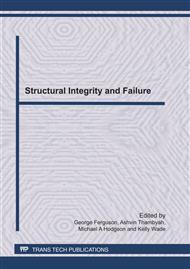p.23
p.27
p.31
p.35
p.39
p.43
p.47
p.51
p.55
Fatigue Behavior of Weld-Repaired High Strength Low Alloy Steel
Abstract:
Fatigue crack growth properties of Bisplate 80, a high strength low alloy (HSLA) steel, with extensive weld repair have been studied. Fatigue cracking becomes relevant if extensive abrasive wear damage is repaired through welding because of the change in material properties. In this study, extended compact tension (E-CT) specimens of Bisplate 80 with and without weld repair, and with and without a buffer layer between the weld and parent material are used to evaluate the fatigue crack growth behaviour. Fatigue crack growth rates are closely monitored at the interface regions between the weld, buffer layer and parent metal. Detailed SEM observations are also conducted at those locations. It is expected that the experimental results can provide useful information on the optimum weld repair conditions of HSLA.
Info:
Periodical:
Pages:
39-42
Citation:
Online since:
July 2011
Authors:
Keywords:
Price:
Сopyright:
© 2011 Trans Tech Publications Ltd. All Rights Reserved
Share:
Citation:


